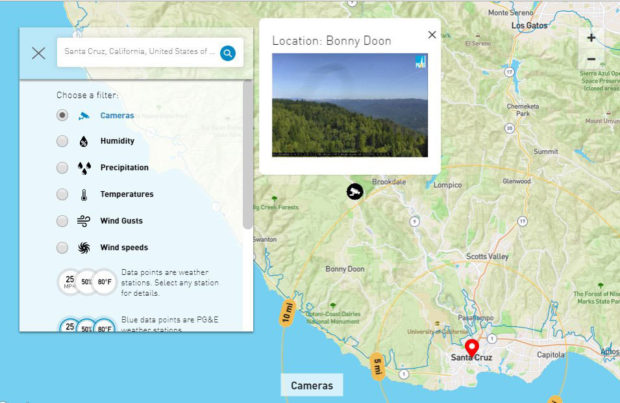New weather webpage gives PG&E customers localized forecasts

SAN FRANCISCO — As part of its efforts to prepare customers and communities for the growing threat of wildfire, Pacific Gas and Electric Company (PG&E) has launched a weather webpage on pge.com, providing detailed, localized forecasts.
The page offers a seven-day, look-ahead regional forecast updated daily by a PG&E meteorologist or fire scientist that indicates the potential need to call a Public Safety Power Shutoff (PSPS).
PG&E monitors conditions and evaluates whether to proactively turn off electric power lines, in the interest of public safety, if gusty winds and dry conditions, combined with a heightened fire risk, threaten a portion of the electric system.
That PG&E 7-Day PSPS Potential forecast will provide an instantaneous sense of what’s going on and what’s ahead. The forecast encompasses nine geographic regions of PG&E’s service area and four levels of PSPS potential:
- Not Expected – Conditions that generally warrant a PSPS event are not expected at this time.
- Elevated – An upcoming event, typically a period of adverse weather combined with dry fuels, is being monitored for an increased potential of a PSPS event.
- PSPS Watch – PG&E’s Emergency Operations Center (EOC) is now activated based upon a reasonable chance of executing a PSPS to reduce public safety risk in a given geographic zone due to a combination of adverse weather and dry fuel conditions. A PSPS watch is typically only issued within 72 hours before the anticipated start of an event.
- PSPS Warning – Customers in areas being considered for a PSPS have been or are being notified. This level indicates execution of a PSPS is probable given the latest forecast of weather and fuels and/or observed conditions. PSPS is typically executed in smaller and more targeted areas than the PG&E Geographic Zones. This level does not guarantee a PSPS execution as conditions and forecasts might change.
But beyond PSPS information, weather geeks will find a lot to love about the new weather page (www.pge.com/weather). With PG&E’s weather map at your fingertips you’ll be able to check humidity, precipitation, temperatures, wind speeds and wind gusts across 70,000 square miles of Northern and Central California. And you can check out those same conditions in your hometown, based on the closest weather station.
Additionally, the map shows whether the National Weather Service has called a Red Flag Warning and where. It also offers access to the thousands of weather stations and dozens of high-definition cameras in use by PG&E. There’s even a daily sunrise and sunset timetable.
No single factor drives a Public Safety Power Shutoff, as each situation is unique. PG&E carefully reviews a combination of many criteria when determining if power should be turned off for safety. These factors generally include, but are not limited to:
- A Red Flag Warning declared by the National Weather Service
- Fire Potential Outlooks from the Interagency Geographic Area Coordination Centers (GACCs)
- Low humidity levels, generally 20 percent and below
- Forecasted sustained winds generally above 25 mph and wind gusts in excess of approximately 45 mph, depending on location and site-specific conditions such as temperature, terrain and local climate
- Condition of dry fuel on the ground and live vegetation (moisture content)
- On-the-ground, real-time observations from PG&E’s Wildfire Safety Operations Center and observations from PG&E field crews
“By expanding our network of weather stations and cameras and offering this real-time information to our customers and agency partners, PG&E continues to grow Northern and Central California’s awareness of weather patterns and the need to initiate a Public Safety Power Shutoff when conditions merit it,” said PG&E Meteorologist Scott Strenfel. “Customers and communities need to prepare, and this weather intelligence complements the letters, community open houses, webinars, workshops, social media posts and more that we’ve used to emphasize that message.”
For information about fire conditions in California, go to CAL FIRE’s website, www.fire.ca.gov. For more information about the Community Wildfire Safety Program, including links to update contact information, resources for Public Safety Power Shutoffs and a schedule of upcoming regional open houses and webinars, visit PG&E’s website at www.pge.com/wildfiresafety.
Click here for more weather related news."

